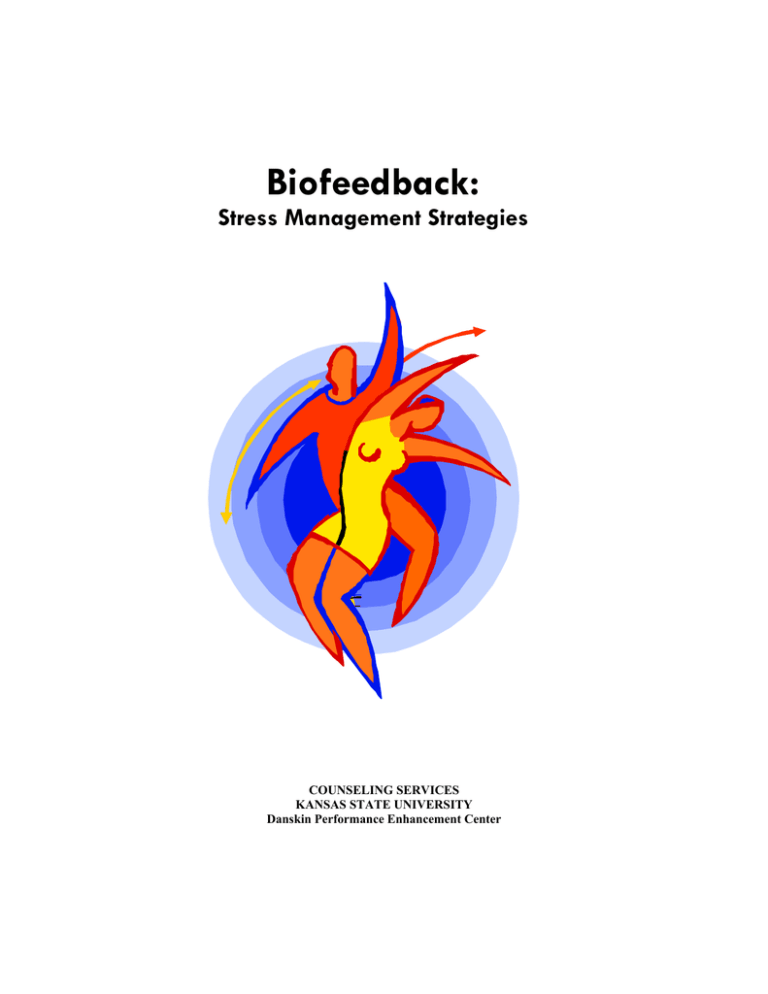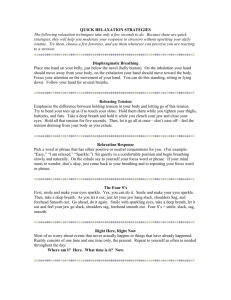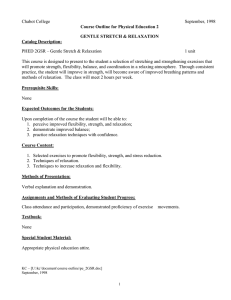Biofeedback: Stress Management Strategies COUNSELING SERVICES
advertisement

Biofeedback: Stress Management Strategies COUNSELING SERVICES KANSAS STATE UNIVERSITY Danskin Performance Enhancement Center Stress Management Strategies for Students Introduction This booklet presents quick relaxation strategies that students can use to help moderate their stress response and activate their relaxation response. Utilizing these quick strategies can help students be less tense, feel calmer, and perform better in what they do. Provided first in this booklet is a brief explanation of the stress response and the symptoms associated with chronic stress response. The relaxation response and the beneficial effects associated with regular activation of it are covered next. Lastly, the relaxation strategies are presented along with tips on how to incorporate them into one’s daily routine. What is Stress? Stress can be defined as our emotional, cognitive, physical, and behavioral reaction to any perceived demands or threats, also called stressors. Having some stress is necessary. Some stress, some level of arousal, is needed to motivate us to act, take on challenges, and meet deadlines. However, experiencing too much stress–that is, being overly aroused continuously for long intervals and being this way over many days–cans become problematic. This experience is often known as being “stressed out.” The Stress Response (or The Fight or Flight Response) ! When we perceive a demand or threat, we become aroused. Our bodies react quickly, activating our physiological systems to be able to fight against or run away from the threat. ! This physiological reaction, called the stress response or the fight or flight response, works well to take on physical threats. ! Our primitive ancestors faced physical threats daily; however, in current times, we rarely experience actual physical threats. Even so, a perceived emotional or psychological stressor can cause our bodies to react in the same way as a physical threat does. For example, anticipating doing poorly on a test or being embarrassed while giving a class presentation can elicit the stress response. Page 1 Physiological Changes During the Stress Response 1. 2. 3. 4. Breathing rate increases Heart rate increases Blood pressure increases Muscle tension increases Symptoms of Chronic Stress Response 1. Experiencing the stress response many times during the day is common. People who study the stress response estimate that, in a typical day, we react physically as many as 50 to 200 times to non-physically threatening events. 2. If we do not have effective ways of moderating the stress response, then experiencing it numerous times throughout the day over many days can eventually hurt our well being, decrease our performance in the various activities we do, and strain our relationships. Type of Symptom Examples Physical symptoms Fatigue, grinding teeth, headaches, muscle and joint pain Cognitive symptoms Poor attention or concentration, blaming others, poor problem solving Behavioral symptoms Changes in activity, loss of appetite, alcohol consumption, withdrawal Emotional symptoms Feelings of anxiety or guilt, irritability, uncertainty Page 2 Managing the Stress Response & Activating the Relaxation Response with Quick Relaxation Strategies An effective way to manage our stress is to use relaxation techniques to moderate the stress response and activate the relaxation response. Even though we may not be able to eliminate many of the stressors we face frequently throughout the day, we can adjust the way we react to them. Effective relaxation techniques help “short circuit” the stress response, keeping our bodies from becomingly overly aroused in the face of a perceived stressor. Relaxation techniques can: • decrease the stimuli that activate the stress response. • replace threatening stimuli with non-threatening stimuli that activate the relaxation response in our bodies. Physiological Changes During the Relaxation Response Breathing rate decreases Heart rate decreases Blood pressure decreases Muscle tension decreases Beneficial Effects from Regular Activation of The Relaxation Response • • • • • • Decreased physical symptoms related to stress Decreased anxiety Decreased negative thoughts and self-criticism Increased concentration and focus Increased performance and efficiency in daily tasks and activities Improved sleep Page 3 How to Get the Most Benefit from the Quick Relaxation Strategies Three steps are encouraged: 1. 2. 3. Select some strategies that work best for you. Decide when you are going to use them. Surround yourself with reminders to use them until they become habit. (A piece of yarn tied to you backpack or a sticky note could serve as helpful reminders.) The goal of the three steps is to make the strategies become a normal, unobtrusive part of your daily life. QUICK RELAXATION STRATEGIES The following relaxation techniques only take a few seconds. Because these are quick strategies, they will help you moderate your stress response without upsetting you daily routine. DIAPHRAGMATIC BREATHING Place one hand on your belly, just below the navel (belly button). On the inhalation your hand should move away from your body, on the exhalation it should move toward the body. Focus your attention on the movement of your hand. You can do this standing, sitting or lying down. RELAXATION RESPONSE Pick a word or phrase that has either positive or neutral connotations for you. (For example: “I am relaxed,” “Easy,” “Sparkle.”) Sit quietly in a comfortable position and begin breathing slowly and naturally. On the exhale say to yourself your focus word or phrase. If your mind starts to wonder, that’s okay, just come back to your breathing and to repeating your focus word or phrase. Page 4 Cal m THE FOUR S’s First, smile and make your eyes sparkle. Yes, you can do it. Smile and make your eyes sparkle. Then, take a deep breath. As you let it out, just let your jaw hang slack, shoulders Sag, and forehead Smooth out. Go ahead, do it again. Smile with sparkling eyes, take a deep breath, let it out and feel your jaw go slack, shoulders sag, and forehead smooth out. Four S's = smile, slack, sag, smooth. RIGHT HERE, RIGHT NOW Most of us worry about events that never actually happen or things that have already happened. Reality consists of one time and one time only, the present. - Repeat to yourself as often as needed each day: Where am I? Here. What time is it? Now. RELEASING TENSION Emphasize the differences between holding tension in your body and letting it go. Try to bend your toes up as if to touch your shins. Hold them there while you tighten your thighs, buttocks, and fists. Take a deep breath and hold it while you clench your jaw and close your eyes. Hold all that tension for five seconds. Then, let it go all at once–don't ease off–feel the tension draining from your body as you exhale. COOL AIR IN, WARM AIR OUT With your eyes closed, shift your attention to the tip of your nose. As you breathe in, become aware of the air coming into your nostrils. As you breathe out, be aware of the sensation of the air passing back out. Perhaps you notice that the air coming in tends to be cooler and the air breathed out tends to be warmer. Just be aware of cool air in . . . and warm air out. Focusing on a physiological activity (air in and out) can help calm your mind and relax your body. Page 5 HEAVY FEET Just image that your feet and legs are getting heavier and heavier with each breath out. It's almost as if you are wearing lead boots. My feet are heavy. My feet are heavy. Just imagine this for a few seconds. Or, perhaps imagining heaviness in some other part of your body (e.g., arms, shoulders, or jaw) works for you. WARM HANDS Visualize your hands as warm and relaxed. You might imagine them in a bucket of warm water, near a fire, or in a warm pair of fleece gloves. Perhaps you can even begin to feel the warm blood flowing down into your hands down to your fingertips. Your hands are warm and relaxed. EQUALIZING BREATHING Take four seconds to breathe in and four seconds to breathe out. That is, as you inhale, count: one . . . two . . . three . . . four. Do the same as you breathe out. Do this four or five times. Avoid holding your breath after the inhalation or the exhalation, just smoothly transition from one phase to the other. YOUR RELAXATION PLACE Begin with a few relaxation breaths. Then with your eyes closed, take a moment to create in your mind’s eye an ideal spot to relax. You can make it any place you’d like, such as the mountains, beach, lake, prairie, or park. It can be either a real or an imagined place. See yourself comfortably enjoying this place. Now, once you have created it, go use it for 15 seconds or so whenever you feel the need to relax. SHOULDER SHRUGS Raise your shoulders as if trying to touch your ears with them. Breathe in while doing this. Feel the muscles in your neck and shoulders tense. Then, all at once, let your shoulders drop while breathing out. Feel the tension leaving the muscles of your neck and shoulders. Repeat the shrug a few times, inhaling on the shrug and exhaling on the release. Keep your jaw relaxed as you do these. Page 6 STRESS AND OUR LIFESTYLE Stress is related to other aspects of our lifestyles--our diet, exercise patterns, thoughts, and environment. Now that you have read about quick relaxation strategies you may want to explore these other areas and initiate changes in one or two of them. Do so! Adopting a healthier lifestyle by taking proactive steps to manage stress leads to a longer and more fulfilling and enjoyable life. Please Note: People who have a history of such chronic stress disorders as tension or migraine headaches, excessive fatigue, insomnia, ulcers, depression, or high blood pressure should seek a professional who offers more intensive stress-management training. Also, reducing your stress levels may reduce your need for insulin, thyroid replacements, tranquilizers, anti-hypertension, and anti seizure medications. If you are on such medication, arrange with your physician to monitor these levels. Consult with the counseling services or mental health center on your campus about more intensive stress management training. Authors: Douglas W. Newton, M.S. Project Wellness Kansas State University Rusty Fulmer, M.S. Kansas State University Terri Unterberger, B.S Kansas State University Some of the information was adapted from the booklet “Quick-Mini: Stress Management Strategies for Students” written by David G. Danskin, Ph.D., 1984. The “Relaxation Response” technique was adapted from Herbert Benson in Benson, H. & Stuart, E. M. (1992). The Wellness Book. NY: Simon & Schuster. Page 7 Thermal Biofeedback-Practice Routine 1. Practice fifteen minutes each day, using one or more of the methods in your handout. 2. Begin by taping a thermometer on the index finger of your non-dominant hand. 3. Sit comfortably in a chair, feet flat on the floor, back straight, hands in lap, palms up. 4. Record starting temperature on the log sheet. 5. Record ending temperature and note the difference between your starting and ending temperatures on log sheet. 6. Use mini-stress management methods throughout the day. 7. Follow this routine for at least one week before making any changes. Page 8 PRACTICE LOG Counseling Services Kansas State University Name: __________________________________________ Date Time Begin Temp. End Temp. What were the physical sensations as you went through today’s practice? What were your feelings? Change What were your thoughts? Temp. Were they in words or images, or both? Page 9







